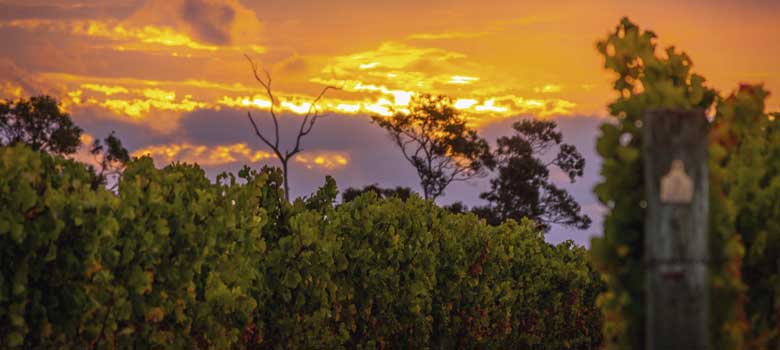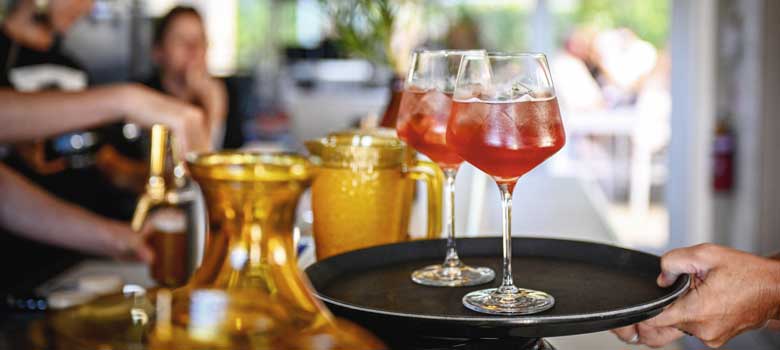
Wine
Margaret River: A quiet revolution
Inspiration for Margaret River’s modern food and wine experience has come from the ancient bounty of its natural landscape.
Some years ago, Bruce Dukes, the owner-winemaker behind Domaine Naturaliste, summed up the draw of Margaret River for many winemakers. An eloquent ode to fruit, he said, “it has beautiful fragrances, perfumes and textures, that we can seemingly translate to quite meaningful styles, to make wines of great fruit freshness and great elegance. I think it’s those things that are important to me and I think it probably comes back to the fundamental ingredients that whatever the interaction between the site, the soil, the climate, the viticulturist, the variety; whatever that magic combination is, that seems to be present in a lot of Margaret River fruit. Having that raw ingredient allows us to do something pretty special and pretty exciting.”
Duke’s words stuck, as did the magic ingredients of other winemakers: a maritime influence between two capes – Naturaliste and Leeuwin – edging into the Indian and Southern Oceans, a cooling influence after long hot summer days, yet a source of recharging rains in winter; ancient soils; and a culture driven by a love of surf and wild coast as much as wine, drawing talent, be it winemakers, chefs, growers or creatives to this isolated region.
Left: Bruce Dukes in his Domaine Naturaliste vineyard; Right: A dramatic skyscape at Juniper’s Karridale vineyard
At Domaine Naturaliste, the cellar door butts against a vineyard block; tables set for tasting, but equally you can take a glass, a charcuterie board and graze. In Wilyabrup, considered the centre of Margaret River quality, names like Woodlands, Cullen, Juniper Estate, Vasse Felix, and Ashbrook Estate resound. Call at these wineries, and others, and it’s clear a quiet revolution is underway; a long-held observance to, or march towards, organic growing, and more recently, an evolution in experience for visitors.
It’s difficult to believe Fraser Gallop Estate was cattle country until 1999. Vigneron Nigel Gallop planted vineyard blocks of regional cornerstones, Cabernet Sauvignon and Chardonnay, alongside Merlot, Semillon, Petit Verdot and Cabernet Franc. A Taste of the Vineyard showcases their flagship Parterre range. On electric carts guests tour the estate tasting at the cellar door, in the estate’s Azalea Garden and beside a Chardonnay block with views across the lake to stately Gallop House.

Above: The Domaine Naturaliste vineyard
Winery processes are explained for both the novice and more informed, delving deep into Fraser Gallop’s use of French oak. A pink blazer hangs on the winery wall. Innocuous to some, it’s awarded to the winner of the Chr. Hansen Trophy for Best Rosé at the Langton’s Margaret River Wine Show. Scooped by Chief Winemaker Clive Otto for the Fraser Gallop Estate Rosé 2020, it’s just one accolade of recent years.
sustainable choices
Close to Yallingup, there’s the feeling at Windows Estate that taking a less conventional route pays off. Chris and Jo Davies have just 15 acres under vine, tended exclusively by Chris. On a walk of the property, Jo comments that his attention is the organically certified vineyard. Pointing to the winery she says, “it’s probably Chris’ least favourite place,” his ethos very much that wine is made in the vineyard.
A night in Windows’ Petit Eco Cabin is sought after, sitting sympathetically within the landscape between a Chardonnay block and one of the vineyard’s dams, it’s a picture of sustainable luxury. As the sun sets, taking a soak in an open-air tub to a soundtrack of black cockatoos and the first throes of a frog chorus, hotel stays may never again be enough.

Above: Windows Estate’s Petit Eco Cabin
Vasse Felix, a founding winery established in 1967 has cultivated a reputation for dining by the vine. In recent years, chef Brendan Pratt has carried the flame. He favours minimalist menu descriptors, but “beef, xo, milk, radicchio,” belies the technique at work. Ultimately it pays to have Pratt explain beyond even the server’s succinct presentation of the dish at the table.
Pratt tells me that a radicchio leaf, which encases the beef, is tossed in house-made tomato and anchovy XO sauce before being grilled over coals. As for the milk element, “It’s smoked beef fat milk,” says the chef.
“Using the rendered and smoked fat off the rumps that we use. Milk is infused with garlic and bay leaves and then seasoned with an aged anchovy extract and soy that we make from bonito flakes. We then stream in the rendered fat to emulsify it into the milk.”
While winery dining is almost exclusively lunch sittings, there’s a growing number of nationally renowned casual dinner spots. In Dunsborough, an oceanside township at the northern end of the capes, a collaboration between Snake + Herring winery and chef Aaron Carr, formerly of Vasse Felix, brought us Yarri back in 2018. A different vibe for Carr, you might find octopus, squid or prawns, lightly brushed in miso butter, or as is, coming off the wood grill. “The menu changes weekly so it just depends on what’s available,” says Carr.
Left: A local catch at Yarri; Right: Ben McDonald in his Glenarty Road vineyard
Nearby newcomer, Lady Lola, is a sea change for chef Michelle Forbes and her partner Marinela Antonic, and indicative of the direction many city chefs are taking: heading to the regions, especially the coast, opening more intimate venues. A Thursday evening and Forbes is the lone figure in the open kitchen-cum-bar, serving up salty vitello tonnato with capers, house made maccheroni and finely plated scallops. The wine list shuns parochialism. You’re as likely to find a small batch biodynamic McLaren Vale drop as you are a Margaret River Blanc de Blanc.

Above: Drinks are up at Lady Lola
southern rewards
While undeniably much of the action is north of Margaret River township, heading south has its rewards. Leeuwin Estate and its neighbour Voyager Estate (who recently announced their organic conversion) are two heavy hitters when it comes to both reputations in the wider wine world and estate experiences.
Stella Bella winemaker Luke Jolliffe, whose Luminosa vineyard neighbours those heavy hitters says their focus is southern Margaret River, with vineyards stretching south to Augusta. While their classic expressions of Cabernet Sauvignon and Chardonnay have a foothold in the consciousness of those tuned into Margaret River, they’ve found a place in recent years for “more exotic varietals,” through their Otro Vino label.
A “winemaker’s playground” says Jolliffe. “Our Tempranillo, Sangiovese, on skins Sauv Blanc. I guess it’s a bit more experimental. It didn’t make sense having those alternative varietals in there. So, we created this new label, to do it differently: low preservative, no additions, a lot of them aren’t filtered.”
Left: Stella Bella winemaker Luke Jolliffe; Right: Farm to table eating at Glenarty Road
Not far from Stella Bella’s Karridale production winery more is afoot, redefining what some term the “deep south.” Idee Fixe, the Blanc de Blanc house launched by Vasse Felix, at what was Watershed winery just south of Margaret River, takes its fruit from a Karridale vineyard. It’s a product very much defined by its southern locality.
Nearby Glenarty Road has come to exemplify farm to table eating in the region as well as an expression of winemaking in the south. Lamb, beef and pork on the menu of the rustic restaurant are raised by generational farmer Ben McDonald, as are macadamias and much of the fruit and veg. On the wine front, while there’s classic Chardonnay and Syrah, there’s also their experimental focus: single varietal Savagnin, Vermentino, Fiano and Pinot Noir (a varietal more prevalent east of Margaret River), a field blend of Vermentino and Fiano, and of course a Pet Nat.
For those exploring north to south, Glenarty Road could be the end. But venturing further south to Cape Leeuwin you get a sense of that maritime power that is such a force in the region’s winemaking. A fitting end, or perhaps just the beginning?